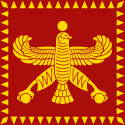Eber-Nari
| Eber-Nari | |||||||||
|---|---|---|---|---|---|---|---|---|---|
| Province of Achaemenid Empire | |||||||||
| 539 BCE–332 BCE | |||||||||
 Standard of Cyrus the Great | |||||||||
| History | |||||||||
| Historical era | Achaemenid era | ||||||||
• Conquest of Chaldea | 539 BCE | ||||||||
• Conquests of Alexander the Great | 332 BCE | ||||||||
| |||||||||
Eber-Nari (Akkadian also Ebir-Nari, Abar-Nahara עבר-נהרה (Aramaic) or 'Ābēr Nahrā (Syriac) meaning "Beyond the River" or "Across the River" in both the Akkadian and Imperial Aramaic languages of the Neo-Assyrian Empire, i.e., the Western bank of the Euphrates from a Mesopotamian and Persian viewpoint), also referred to as Transeuphratia (French: Transeuphratène) by modern scholars, was a region of Western Asia and a satrapy of the Neo-Assyrian Empire (911–605 BC), Neo-Babylonian Empire (612–539 BC) and Achaemenid Empire (539–332 BC). The Akkadian Eber-Nari is referred to as Athura or Athuriya in Old Persian, and Aššur in the Elamite.[1][2] The Targum Onkelos lists Nineveh, Calah, Reheboth, and Resen as being in the jurisdiction of Athura.